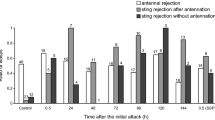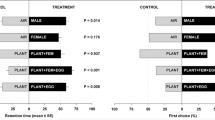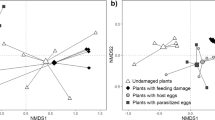Abstract
Ceroptera rufitarsis (Meigen) (Diptera: Sphaeroceridae) is a tiny fly phoretic on several roller dung beetles of the genus Scarabaeus L. (Coleoptera: Scarabaeidae). We investigated the attractiveness of Scarabaeus sacer L. and S. cicatricosus Lucas both under field and laboratory conditions. Several cues potentially responsible for the host finding behavior were tested in order to determine the basis of attraction of Ceroptera rufitarsis to Scarabaeus beetles. Visual cues, especially host movements, constituted the main factor responsible for host finding behavior and host choice while chemical cues did not play any role in host discrimination.

Similar content being viewed by others
References
Aluja M, Prokopy RJ (1993) Host odour and visual stimulus interaction during intra tree host finding behaviour of Rhagoletis pomonella flies. J Chem Ecol 19:2671–2696
Cambefort Y (1991) From saprophagy to coprophagy. In: Hanski I, Cambefort Y (eds) Dung beetle ecology. Princeton University Press, Princeton, pp 22–35
Cambefort Y, Hanski I (1991) Dung beetle population biology. In: Hanski I, Cambefort Y (eds) Dung beetle ecology. Princeton University Press, Princeton, pp 36–50
Cournoyer M, Boivin G (2005) Short distance cues used by the adult parasitoid Microctonus hyperodae Loan (Hymenoptera: Braconidae, Euphorinae) of host selection of a novel host Listronotus oregonensis (Coleoptera: Curculionidae). J Insect Behav 18:577–591
Fabre JH (1897) Souvenirs Entomologiques. Etudes sur l'instinct et les moeurs des insectes. Cinquieme serie, Editions Delagrave, Paris
Farish DJ, Axtell RC (1971) Phoresy redefined and examined in Macrocheles muscaedomesticae (Acarina: Macrochelidae). Acarologia 13:523–531
Glida H, Bertrand M, Peyrusse V (2003) A limiting factor in the abundance of predatory phoretic mites (Acari: Macrochelidae): the seasonal abundance of their phorionts (dung beetles) in southern France. Can J Zool 81:2066–2072
Godfay HCJ (1994) Parasitoid: Behavioural and evolutionary ecology. Princeton University Press, Princeton
Harris MO, Miller JR (1988) Host-acceptance behaviour in an herbivorous fly, Delia antique. J Insect Physiol 34:179–190
Harris MO, Rose S (1990) Chemical, colour, and tactile cues influencing oviposition behavior of the Hessian fly (Diptera: Ceridomyiidae). Environ Entomol 19:303–308
Lesne P (1896) Moeurs de Limosina sacra Meig. (Famille Muscidae, tribu Borborenae). Phenomenes de transport mutuel chez les animaux articules. Origine du parasitisme chez les insectes Dipteres. Bull Soc Entomolog Fr:162–165
Lobo JM, Martin-Piera F, Veiga CM (1988) Las trampas pitfall con cebo, sus posibilidades en el estudio de las comunidades coprofagas de Scarabaeidae (Col.). I. Caracteristicas determinantes de su capacidad de captura. Rev Ecol Biol Sol 25:77–100
McAuslane HJ, Vinson S, Williams HJ (1991b) Stimuli influencing host microhabitat location in the parasitoid Campoletis sonorensis. Entomol Exp Appl 58:267–277
Monteith LG (1956) Influence of host movement on selection of hosts by Drino bohamica Mesn. as determined in an olfactometer. Can Entomol 88:583–586
Morehead SA, Feener DH (2000) Visual and chemical cues used in host location and acceptance by a dipteran parasitoid. J Insect Behav 13:613–625
Niogret J, Lumaret JP, Bertrand M (2006) Semiochemicals mediating host-finding behaviour in the phoretic association between Macrocheles saceri (Acari: Mesostigmata) and Scarabaeus species (Coleoptera: Scarabaeidae). Chemoecol 16:129–134
Petersson E, Sivinski J (1996) Attraction of a kleptoparasitic Sphaerocerid fly (Norrbomia spp. and Canthon sp.). J. Insect Behav 9:695–708
Philipps CB (2002) Observations of oviposition behavior of Microctonus hyperodae Loan and M. aethiopoids Loan (Hymenoptera: Braconidae: Euphorinae). J Hym Res 11:326–337
Prokopy RJ, Owens ED (1983) Visual detection of plant of host plants by herbivorous insects. Ann Rev Entomol 28:337–364
Prokopy RJ, Bergweiler C, Galarza L, Schwerin J (1994) Prior experience affects the visual ability of Rhagoletis pomonella flies (Diptera: Tephritidae) to find host fruit. J Insect Behav 7:663–677
Roháček J (1998) Family Sphaeroceridae. In: Papp L, Darvas B (Ed) Contributions to a Manual of Palaearctic Diptera, vol 3. Science Herald Budapest. pp 463–496.
Rougon D, Rougon C (1980) Contribution à la biologie des Coléoptères coprophages en région sahélienne. Etude du développement d’Onthophagus gazella (Coleoptera: Scarabaeidae). Rev Ecol Biol Sol 17:379–392
Sivinski J (1983) The natural history of a sphaerocerid Diptera fauna. Ecol Entomol 8:419–426
Sivinski J (1984) Sexual conflict and choice in a phoretic fly, Borborillus frigipennis (Sphaeroceridae). Ann Entomol Soc Am 77:232–235
Sivinski J, Marshall S, Petersson E (1999) Kleptoparasitism and phoresy in the Diptera. Fla Entomol 82:179–197
Veiga CM, Lobo JM, Martin-Piera F (1989) Las trampas pitfall con cebo, sus posibilidades en el estudio de las comunidades coprofagas de Scarabaeidae (Col.). II. Analisis de efectividad. Rev Ecol Biol Sol 26:91–109
Wäckers FL, Lewis WJ (1994) Olfactory and visual learning and their combined influence on host site location by the parasitoid Microplitis croceipes (Cresson). Biol Control 4:105–112
Acknowledgements
This study was supported by the French Entomological Society (SEF; grant Germaine Cousin, Paris). The authors thank L. Papp (Hungarian Natural History Museum) and M. Martinez (INRA Montpellier, France) for Ceroptera species identification. We thank D. Ghaioule and N. Maatouf (National Center of Forestry of Morocco, DREF Rabat Agdal) for field assistance, S. Pla for technical help and anonymous referees whose comments were very useful.
Author information
Authors and Affiliations
Corresponding author
Rights and permissions
About this article
Cite this article
Niogret, J., Lumaret, J.P. Identification of the Cues Used in the Host Finding Behavior During the Phoretic Association Ceroptera rufitarsis (Diptera: Sphaeroceridae) and Dung Beetles (Coleoptera: Scarabaeidae). J Insect Behav 22, 464–472 (2009). https://doi.org/10.1007/s10905-009-9185-0
Revised:
Accepted:
Published:
Issue Date:
DOI: https://doi.org/10.1007/s10905-009-9185-0




